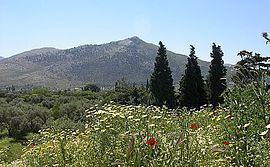Lowest elevation 0 m (0 ft) Area 226.6 km² Mayor Ilias Psinakis | Administrative region Attica Elevation 28 m (92 ft) Time zone EET (UTC+2) Population 7,170 (2011) Local time Monday 11:41 PM | |
 | ||
Weather 12°C, Wind W at 0 km/h, 73% Humidity | ||
Marathon (Demotic Greek: Μαραθώνας, Marathónas; Attic/Katharevousa: Μαραθών, Marathṓn) is a town in Greece, the site of the battle of Marathon in 490 BC, in which the heavily outnumbered Athenian army defeated the Persians. The tumulus or burial mound (Greek Τύμβος, tymbos, tomb) of the 192 Athenian dead, also called the "Soros", which was erected near the battlefield, remains a feature of the coastal plain. The Tymbos is now marked by a marble memorial stele and surrounded by a small park.
Contents
- Map of Marathonas 190 07 Greece
- History
- Municipality
- Population
- Points of interest
- Sister cities
- References
Map of Marathonas 190 07, Greece
History
The name "Marathon" (Μαραθών) comes from the herb fennel, called marathon (μάραθον) or marathos (μάραθος) in Ancient Greek, so Marathon literally means "a place full of fennels". It is believed that the town was originally named so because of an abundance of fennel plants in the area.
After Miltiades (the general of the Greek forces) defeated Darius' Persian forces, the Persians decided to sail from Marathon to Athens in order to sack the unprotected city. Miltiades ordered all his hoplite forces to march "double time" back to Athens, so that by the time Darius' troops arrived they saw the same Greek force waiting for them.
The name of the athletic long-distance endurance race, the "marathon", comes from the legend of Pheidippides, a Greek soldier and runner who was sent from Marathon to Athens to announce that the Persians had been defeated in the Battle of Marathon.
Although the name Marathon had a positive resonance in Europe in the nineteenth century, for some time that was sullied by the Dilessi murders, which happened nearby in 1870.
The sophist and magnate Herodes Atticus was born in Marathon. In 1926, the American company ULEN began construction on the Marathon Dam in a valley above Marathon, in order to ensure water supply for Athens. It was completed in 1929. About 10 km² of forested land were flooded to form Lake Marathon.
The beach of Schinias is located southeast of the town and it is a popular windsurfing spot and the Olympic Rowing Center for the 2004 Summer Olympics is also located there. At the 1896 and 2004 Summer Olympics, Marathon was the starting point of the marathon races (for both women and men in 2004). The area is susceptible to flash flooding, because of forest fires having denuded parts of the eastern slopes of Mount Penteli especially in 2006.
Municipality
The municipality Marathon was formed at the 2011 local government reform by the merger of the following 4 former municipalities, that became municipal units:
The municipality has an area of 222.747 km2, the municipal unit 97.062 km2.
Population
The other settlements in the municipal unit are Agios Panteleimonas (pop. 1,591), Kato Souli (2,142), Vranas (1,082), Avra (191), Vothon (177), Ano Souli (232), and Schinias (264).
